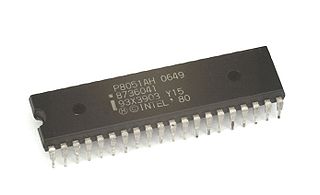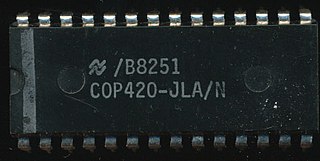Related Research Articles

The Nova is a series of 16-bit minicomputers released by the American company Data General. The Nova family was very popular in the 1970s and ultimately sold tens of thousands of units.

The 68HC11 is an 8-bit microcontroller family introduced by Motorola Semiconductor in 1984. It descended from the Motorola 6800 microprocessor by way of the 6801. The 68HC11 devices are more powerful and more expensive than the 68HC08 microcontrollers and are used in automotive applications, barcode readers, hotel card key writers, amateur robotics, and various other embedded systems. The MC68HC11A8 was the first microcontroller to include CMOS EEPROM.

The Zilog Z80 is an 8-bit microprocessor designed by Zilog that played an important role in the evolution of early computing. Launched in 1976 and software-compatible with the Intel 8080, it offered a compelling alternative due to its better integration and increased performance. As well as the 8080's seven registers and flags register, the Z80 had an alternate register set that duplicated them, two 16-bit index registers and additional instructions including bit manipulation and block copy/search.

The Intel MCS-51 is a single-chip microcontroller (MCU) series developed by Intel in 1980 for use in embedded systems. The architect of the Intel MCS-51 instruction set was John H. Wharton. Intel's original versions were popular in the 1980s and early 1990s, and enhanced binary compatible derivatives remain popular today. It is a complex instruction set computer with separate memory spaces for program instructions and data.

PIC is a family of microcontrollers made by Microchip Technology, derived from the PIC1640 originally developed by General Instrument's Microelectronics Division. The name PIC initially referred to Peripheral Interface Controller, and was subsequently expanded for a short time to include Programmable Intelligent Computer, though the name PIC is no longer used as an acronym for any term. The first parts of the family were available in 1976; by 2013 the company had shipped more than twelve billion individual parts, used in a wide variety of embedded systems.
Addressing modes are an aspect of the instruction set architecture in most central processing unit (CPU) designs. The various addressing modes that are defined in a given instruction set architecture define how the machine language instructions in that architecture identify the operand(s) of each instruction. An addressing mode specifies how to calculate the effective memory address of an operand by using information held in registers and/or constants contained within a machine instruction or elsewhere.
The TMS9900 was one of the first commercially available single-chip 16-bit microprocessors. Introduced in June 1976, it implemented Texas Instruments's TI-990 minicomputer architecture in a single-chip format, and was initially used for low-end models of that lineup.

The Fairchild F8 is an 8-bit microprocessor system from Fairchild Semiconductor, announced in 1974 and shipped in 1975. The original processor family includes four main 40-pin integrated circuits (ICs); the 3850 CPU which is the arithmetic logic unit, the 3851 Program Storage Unit (PSU) which contains 1 KB of program ROM and handles instruction decoding, and the optional 3852 Dynamic Memory Interface (DMI) or 3853 Static Memory Interface (SMI) to control additional RAM or ROM holding the user programs or data. The 3854 DMA is another optional system that adds direct memory access into the RAM controlled by the 3852.
National Semiconductor's SC/MP for Simple Cost-effective Micro Processor, is an early 8-bit microprocessor which became available in April 1976. It was designed to allow systems to be implemented with the minimum number of additional support chips. SC/MP included a daisy-chained control pin that allowed up to three SC/MP's share a single main memory to produce a multiprocessor system, or to act as controllers in a system with another main central processing unit (CPU). Three versions were released over its lifetime, SCMP-1 through 3, the latter two also known as INS8060 and INS8070.
The Atmel AVR instruction set is the machine language for the Atmel AVR, a modified Harvard architecture 8-bit RISC single chip microcontroller which was developed by Atmel in 1996. The AVR was one of the first microcontroller families to use on-chip flash memory for program storage.
TLCS is a prefix applied to microcontrollers made by Toshiba. The product line includes multiple families of CISC and RISC architectures. Individual components generally have a part number beginning with "TMP". E.g. the TMP8048AP is a member of the TLCS-48 family.
The Mitsubishi 740, also known as MELPS 740, is a series of 8-bit CMOS microcontrollers and microprocessors with an enhanced MOS Technology 6502 compatible core based on the expanded WDC 65C02. The ICs were manufactured by Mitsubishi Electric during the 1980s and 1990s.
The 9S08 is an 8-bit microcontroller (μC) family originally produced by Motorola, later by Freescale Semiconductor, and currently by NXP, descended from the Motorola 6800 microprocessor. It is a CISC microcontroller. A slightly extended variant of the 68HC08, it shares upward compatibility with the aging 68HC05 microcontrollers, and is found in almost any type of embedded systems. The larger members offer up to 128 KiB of flash, and 8 KiB of RAM via a simple memory management unit (MMU) which allows bank-switching 16 KiB of the address space and an address/data register pair which allows data fetches from any address. The paging scheme used allows for a theoretical maximum of 4 MB of flash.

The ST6 and ST7 are 8-bit microcontroller product lines from STMicroelectronics. They are commonly used in small embedded applications like washing machines.

The W65C816S is a 16-bit microprocessor (MPU) developed and sold by the Western Design Center (WDC). Introduced in 1985, the W65C816S is an enhanced version of the WDC 65C02 8-bit MPU, itself a CMOS enhancement of the venerable MOS Technology 6502 NMOS MPU. The 65C816 is the CPU for the Apple IIGS and, in modified form, the Super Nintendo Entertainment System.
The PIC instruction set refers to the set of instructions that Microchip Technology PIC or dsPIC microcontroller supports. The instructions are usually programmed into the Flash memory of the processor, and automatically executed by the microcontroller on startup.

The STM8 is an 8-bit microcontroller family by STMicroelectronics. The STM8 microcontrollers use an extended variant of the ST7 microcontroller architecture. STM8 microcontrollers are particularly low cost for a full-featured 8-bit microcontroller.
The Mostek MK5065 was an 8-bit microprocessor introduced by Mostek in early 1974. The design was originally developed by Motorola for use in an Olivetti electronic calculator, and was licensed to Mostek for use in non-calculator roles. It featured three sets of processor registers, allowing it to switch to an interrupt handler in a single cycle, and a wait-for-data mode that aided direct memory access.

The COP400 or COP II is a 4-bit microcontroller family introduced in 1977 by National Semiconductor as a follow-on product to their original PMOS COP microcontroller. COP400 family members are complete microcomputers containing internal timing, logic, ROM, RAM, and I/O necessary to implement dedicated controllers. Some COP400 devices were second-sourced by Western Digital as the WD4200 family. In the Soviet Union several COP400 microcontrollers were manufactured as the 1820 series.
The Rockwell PPS-8, short for "Parallel Processing System, 8-bit", was an early 8-bit microprocessor from Rockwell International, announced in 1974. It had a number of unique design features, which Adam Osborne described as "most unusual... more powerful... also one of the most difficult to understand." It was released with a suite of support chips, including ROM and RAM, parallel and serial controllers, and a direct memory access (DMA) system.
References
- 1 2 COP8 Basic Family User's Manual (PDF). Revision 002. National Semiconductor. June 1996. Literature Number 620895-002. Retrieved 2021-01-02.
- 1 2 Aleaf, Abdul (July 1996). "Comparison of COP878x to the Enhanced COP8SAx7 Family - Hardware/Software Considerations" (PDF). National Semiconductor. Application Note 1043.
- ↑ COP8 Feature Family User's Manual. Revision 005. National Semiconductor. March 1999. Literature Number 620897-005. Extracted from zipped ISO image 530094-003_COP8_Tools_Docs_Aug1999.zip, retrieved 2020-01-07.
- ↑ "COP8SAx Designer's Guide" (PDF). National Semiconductor. January 1997. Literature Number 620894-001.
- 1 2 "COP8SBR9/COP8SCR9/COP8SDR98-Bit CMOS Flash Based Microcontroller with 32k Memory, Virtual EEPROM and Brownout" (PDF) (data sheet). National Semiconductor. April 2002. Retrieved 2021-01-06.
- ↑ Liberatore, David (11 May 2006). FMU-139C/B Electronic Bomb Fuze Design Update (PDF). 50th Annual NDIA Fuze Conference. Retrieved 7 Nov 2024.
- ↑ Dennis, Marc; Hanrahan, Bob; Brackmann, Chris (November 1991). Application Note 761 - Electronic Fuzing (PDF). Texas Instruments. Retrieved 7 Nov 2024.